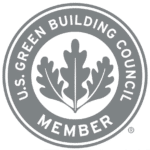Background
USGBC and LEED’s development started in 1993 under three individuals’ guidance and their desire to design and construct environmentally responsible buildings. LEED version 1.0 launched in 1998 and, in 2003, saw a significant number of projects seeking LEED certification. Since then, LEED has been the central green rating system within the United States and has expanded its reach across the world. There are multiple LEED rating systems tailored to different construction types, including new construction, interiors, existing buildings, and residential, to name a few. There are seven credit categories within LEED BD+C, including Integrative Process, Location and Transportation, Sustainable Sites, Water Efficiency, Energy and Atmosphere, Materials and Resources, and Indoor Environmental Quality. Starting with LEED BD+C version 4.0, product transparency and materials’ environmental impacts throughout their life-cycle came into focus under the Materials and Resources credit category. Under this credit category, Environmental Product Declarations (EPDs) and Whole Building Life-Cycle Assessments (WBLCA) became vital, while reuse strategies continue to be rewarded in the rating system.
The latest version of LEED, version 4.1, was released as a beta in 2018 and has been updated quarterly based on stakeholder feedback. In that time, the LEED v4.1 system has undergone several changes to various credits relating to embodied carbon in order to emphasize outcomes and simplify credits. Further updates may happen before the rating system is formally balloted, which is expected in late 2021. Check the LEED credit library at USGBC’s website for the latest versions of credits.
There are multiple LEED BD+C version 4.1 credits under the Materials and Resources category available for structural engineers to help their project team achieve embodied carbon reductions. In general, there are credits that reward design decisions that reward dematerialization and structural choices that reduce intrinsic carbon (such as building reuse and WBLCA), as well as points that reward the selection of products that have conducted life-cycle analysis and optimized their products (EPDs). Finally, projects can procure low carbon materials during the construction phase to further reduce embodied carbon. Table below summarizes the LEED BD+C version 4.1 credits structural engineers can engage in to help their client achieve the target project certification level while reducing the structural system’s embodied carbon.

